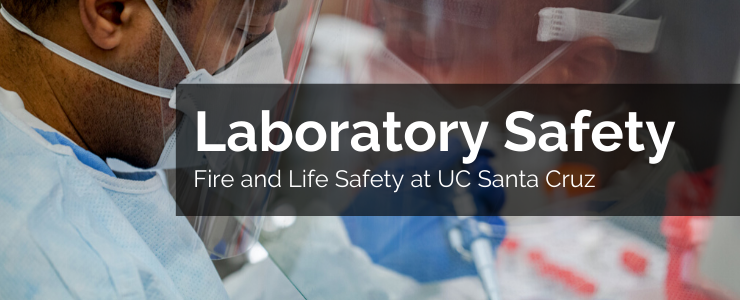Laboratory Safety
UC Santa Cruz is home to world-class research facilities and laboratories. As a result, it is absolutely essential that UCSC adopt stringent and effective safety practices that ensure minimal risk to the campus community and the researchers themselves.
From the Fire Protection perspective, there are specific fire code requirements at UC Santa Cruz that must be upheld. Specifically, UC Santa Cruz laboratories are required to adhere to NFPA Chapter 45 "Standard on Fire Protection for Laboratories Using Chemicals." This chapter lays out concerns that cover a broad spectrum including instructor responsibilities, chemical storage, experiments, fire-rated construction, and fire protection systems.
To supplement this code, there are specific tips and guidelines that can be used to help students and instructors prevent injury and unnecessary risks.
- Evaluate the hazards for research activities and include the appropriate Personal Protective Equipment (PPE) required, safe work practices, relevant emergency procedures, and the disposal of waste.
- Provide a safety briefing that includes all of the above prior to the start of research experiments.
- Ensure that everyone who participates in research is trained in fire safety and emergency procedures before starting.
- Distribute PPE (lab coats, disposable gloves, eye goggles, etc) when needed. Ensure that participants have shoes that cover the entire foot, loose clothing is properly secured, jewelry is secured/removed and hair is pulled back.
- Before starting, make sure that all exits are clear and easily accessible.
- Use fume hoods when performing experiments that involve open flames, fire, or the use of flammable, reactive, toxic, or corrosive chemicals.
- Place a barrier between students and any demonstrations to prevent personal injuries.
- Ensure that all experiments and research work are properly supervised.
- Limit the amount of chemicals stored or used in a laboratory to the minimum needed for the lab's functionality. Keep bulk quantities well away from any active laboratory.
- Do not dispense bulk quantities of chemicals inside a laboratory.
More Information
OSHA Laboratory Safety Guidance (PDF)
CPSC/CDC/NIOSH School Chemistry Laboratory Safety Guide (PDF)

